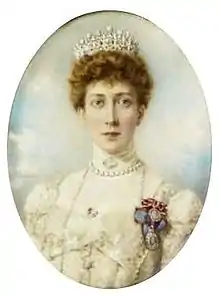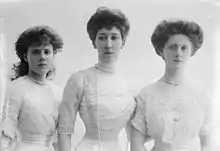Louise, Princess Royal
Louise, Princess Royal and Duchess of Fife VA, CI (Louise Victoria Alexandra Dagmar; 20 February 1867 – 4 January 1931) was the third child and eldest daughter of King Edward VII and Queen Alexandra of the United Kingdom; she was a younger sister of King George V. Louise was given the title of Princess Royal in 1905.[2] Known for her shy and quiet personality, Louise remained a low-key member of the royal family throughout her life.[3]
| Louise | |||||
|---|---|---|---|---|---|
| Princess Royal, Duchess of Fife | |||||
 Louise Princess Royal Duchess of Fife Portrait or Photograph by W. & D. Downey circa, 1910 | |||||
| Born | Princess Louise of Wales 20 February 1867 Marlborough House, London | ||||
| Died | 4 January 1931 (aged 63) Portman Square, London | ||||
| Burial | 10 January 1931 | ||||
| Spouse | Alexander Duff, 1st Duke of Fife
(m. 1889; died 1912) | ||||
| Issue |
| ||||
| |||||
| House | Saxe-Coburg and Gotha (at birth) Duff (by marriage) | ||||
| Father | Edward VII, King of the United Kingdom | ||||
| Mother | Alexandra of Denmark | ||||
Early life and education
_-_Princess_Louise_of_Wales_(1867-1931)_-_RCIN_404995_-_Royal_Collection.jpg.webp)
Louise was born on 20 February 1867 at Marlborough House, the London residence of her parents, the Prince and Princess of Wales.[3] Louise's father was the eldest son of Queen Victoria and Prince Albert. Her mother was the eldest daughter of Christian IX and Queen Louise of Denmark. From birth, as the granddaughter of the British monarch, she had the title Her Royal Highness Princess Louise of Wales.[4][5] She spent much of her childhood at Sandringham House in Norfolk.[3] She was baptised at Marlborough House on 10 May 1867 by Charles Longley, Archbishop of Canterbury.[6] Like her sisters Victoria and Maud, she was educated under the supervision of tutors. She occasionally spent the summer in Denmark, her mother's homeland. In her youth, Louise was described as a very withdrawn girl.[7]
Louise and her sisters, Victoria and Maud, were bridesmaids at the wedding of their paternal aunt Princess Beatrice to Prince Henry of Battenberg in 1885.[8]
Marriage and children

Despite her mother's attempts to keep her daughters unmarried and by her side, on Saturday 27 July 1889, Louise married Alexander Duff, 6th Earl Fife, who was eighteen years her senior, at the Private Chapel in Buckingham Palace with the Archbishop of Canterbury officiating at the service.[9] Her bridesmaids were Princesses Maud and Victoria of Wales, Victoria Mary of Teck, Marie Louise and Helena Victoria of Schleswig-Holstein and the Countesses Feodora, Helena and Valda Gleichen.[9] Two days after the wedding, Queen Victoria created him Duke of Fife and Marquess of Macduff in the Peerage of the United Kingdom. The letters patent creating this dukedom contained the standard remainder to heirs male of the body lawfully begotten.[10] After the birth of their two daughters, on 24 April 1900, Queen Victoria signed letters patent creating a second Dukedom of Fife, along with the Earldom of Macduff in the Peerage of the United Kingdom with a special remainder: in default of a male heir, these peerages would pass to the daughters of the 1st Duke, and then to their male descendants.

The Duke and Duchess of Fife had three children:[7]
- Alastair Duff, Marquess of Macduff (stillborn 16 June 1890)
- Princess Alexandra, 2nd Duchess of Fife (17 May 1891 – 26 February 1959); married her first cousin once removed Prince Arthur of Connaught (13 January 1883 – 12 September 1938), and had issue.
- Princess Maud (3 April 1893 – 14 December 1945); married Charles Carnegie, 11th Earl of Southesk, and had issue.
The couple made their home at Mar Lodge, a sporting lodge built for them by Alexander Marshall Mackenzie.[11]
Princess Royal
On 9 November 1905, Edward VII created Louise the Princess Royal, the highest honour bestowed on a female member of the royal family.[5][12] At the same time, the King declared that the two daughters of the Princess Royal would be styled as princesses, with the style and attribute of "Highness" and with precedence immediately after all members of the royal family bearing the style of "Royal Highness".[13]
On 12 December 1911, while sailing aboard SS Delhi to Egypt, the Princess Royal and her family were shipwrecked off the coast of Morocco.[14] Although they were otherwise unharmed, the Duke of Fife fell ill with pleurisy, probably contracted as a result of the shipwreck.[3] He died at Assuan, Egypt, in January 1912, and Princess Alexandra succeeded to his dukedom, becoming Duchess of Fife in her own right.[7][15]
Later life and death

After the death of her husband, Louise led a reclusive life. Sometimes she accompanied her mother and her sister Victoria to public events. In the years leading up to her death Louise suffered from heart disease.[12] In October 1929 at Mar Lodge she was taken ill with another gastric haemorrhage. and was brought back to London, she lingered in 15 months spending too much time in bed. Louise died in her sleep fifteen months later on the afternoon on 4 January 1931, a month before her 64th birthday, at her home at 15 Portman Square, London, with her two daughters Alexandra and Maud at her bedside her brother King George V and sister Princess Victoria of the United Kingdom wrote to there sister Queen Maud of Norway ”Louise suffered so much terribly these last few months that one can but thank God. She is at peace with her dear ones. But it sad for us and a loss of a sister comes near ones heart.“5 She was buried in St. George's Chapel, Windsor Castle.[12] Her remains were later removed to the Private Chapel, Mar Lodge, Braemar, Aberdeenshire.[5][7] Her will was sealed and her estate was valued at £46,383 (or £2.2 million in 2022 when adjusted for inflation).[16]
Titles, styles,honours and arms
- 20 February 1867 - 27 July 1889 : Her Royal Highness Princess Louise of Wales
- 27 July 1889 - 29 July 1889
- Her Royal Highness Princess Louise Countess of Fife
- 29 July 1889 - 22 January 1901 :Her Royal Highness Princess Louise Duchess of Fife
- 22 January 1901 - 9 November 1905 :Her Royal Highness The Princess Louise Duchess of Fife
- 9 November 1905 - 4 January 1931 :Her Royal Highness The Princess Royal and Duchess of Fife
- 1885: Royal Order of Victoria and Albert
- 1887: Imperial Order of the Crown of India
- 1929: Dame Grand Cross of the Venerable Order of St John of Jerusalem (GCStJ)
- 1888–1929: Lady of the Venerable Order of St John of Jerusalem (LJStJ)
Honorary military appointments
Arms
Upon her marriage, Louise was granted a coat of arms, being the Royal Arms of the United Kingdom with an inescutcheon for Saxony, all differenced with a label argent of five points, the outer pair and centre bearing crosses gules, and the inner pair bearing thistles proper.[19] The inescutcheon was dropped by royal warrant in 1917.
 |
 |
|---|---|
Princess Louise's coat of arms until 1917 |
Fife Arms Hotel, Braemar: Arms of the Duke and Duchess of Fife |
Ancestors
| Ancestors of Louise, Princess Royal | |||||||||||||||||||||||||||||||||||||||||||||||||||||||||||||||||||||||||||||||||||||||||||||||||||||||||||||||||||||||||||||||||||||||||||||||||||||||||||||||||||||||||||||||||||||||||||||||||||||||||||||||||||||||||||||||||||||||||||||||||||||||||||||||||||||||||||||||||||||||||
|---|---|---|---|---|---|---|---|---|---|---|---|---|---|---|---|---|---|---|---|---|---|---|---|---|---|---|---|---|---|---|---|---|---|---|---|---|---|---|---|---|---|---|---|---|---|---|---|---|---|---|---|---|---|---|---|---|---|---|---|---|---|---|---|---|---|---|---|---|---|---|---|---|---|---|---|---|---|---|---|---|---|---|---|---|---|---|---|---|---|---|---|---|---|---|---|---|---|---|---|---|---|---|---|---|---|---|---|---|---|---|---|---|---|---|---|---|---|---|---|---|---|---|---|---|---|---|---|---|---|---|---|---|---|---|---|---|---|---|---|---|---|---|---|---|---|---|---|---|---|---|---|---|---|---|---|---|---|---|---|---|---|---|---|---|---|---|---|---|---|---|---|---|---|---|---|---|---|---|---|---|---|---|---|---|---|---|---|---|---|---|---|---|---|---|---|---|---|---|---|---|---|---|---|---|---|---|---|---|---|---|---|---|---|---|---|---|---|---|---|---|---|---|---|---|---|---|---|---|---|---|---|---|---|---|---|---|---|---|---|---|---|---|---|---|---|---|---|---|---|---|---|---|---|---|---|---|---|---|---|---|---|---|---|---|---|---|---|---|---|---|---|---|---|---|---|---|---|---|---|---|---|
| |||||||||||||||||||||||||||||||||||||||||||||||||||||||||||||||||||||||||||||||||||||||||||||||||||||||||||||||||||||||||||||||||||||||||||||||||||||||||||||||||||||||||||||||||||||||||||||||||||||||||||||||||||||||||||||||||||||||||||||||||||||||||||||||||||||||||||||||||||||||||
References
- "Louise, Princess Royal". The British Museum. Retrieved 8 July 2021.
- "Royal Titles: Style and Title of the Princess Royal". The British Monarchy. n.d. Archived from the original on 27 July 2008. Retrieved 23 January 2018.
{{cite web}}: CS1 maint: unfit URL (link) - "The stories of Queen Victoria's granddaughters: Princess Louise of Wales". Royal Central. 27 July 2015. Retrieved 8 July 2021.
- Eilers 1987, p. 176.
- Weir 2008, p. 320.
- Her godparents were her paternal aunts – Alice, Princess Louis of Hesse, Helena, Princess Christian of Schleswig-Holstein and Princess Louise, Duchess of Argyll; her paternal uncle (by marriage), Crown Prince Frederick William of Prussia; her first cousin once-removed – Grand Duchess Augusta of Mecklenburg-Strelitz; her maternal great-uncle – Elector Frederick William of Hesse-Kassel (or Hesse-Cassel); her maternal grandmother: Queen Louise of Denmark; her children, Louise's uncle, George I of Greece; and aunt, The Tsarevna of Russia; Duke Charles of Schleswig-Holstein-Sonderburg-Glücksburg; and Prince Edward of Saxe-Weimar-Eisenach.
- Reynolds, K. D. "Louise, princess royal and duchess of Fife". Oxford Dictionary of National Biography (online ed.). Oxford University Press. doi:10.1093/ref:odnb/34602. (Subscription or UK public library membership required.)
- "Prince and Princess Henry of Battenberg with their bridesmaids and others on their wedding day". National Portrait Gallery. Retrieved 30 May 2018.
- "The Marriage of Princess Louise of Wales with the Duke of Fife at Buckingham Palace, 27th July 1889". Royal Collection Trust. Retrieved 8 July 2021.
- "No. 25958". The London Gazette. 27 July 1889. p. 4077.
- "Princess Louise's Highland seat(s)". National Trust for Scotland. 1 December 2017. Retrieved 8 July 2021.
- "Princess Louise Dies in Her Sleep". The New York Times. 5 January 1931. Retrieved 8 July 2021.
- "No. 27852". The London Gazette (Supplement). 9 November 1905. p. 7495.
- Hugh Dawson, A Guide to the Chapel of Saint Ninian, Mar Lodge, Braemar. The Scottish Episcopal Church, Braemar 2015
- "ASSUAN, Upper Egypt, Jan. 29" (PDF). The New York Times. 30 January 1912. Retrieved 3 May 2010.
- Evans, Rob; Pegg, David (18 July 2022). "£187m of Windsor family wealth hidden in secret royal wills". The Guardian. Retrieved 19 July 2022.
- Silverstone, Paul H. (1984). Directory of the World's Capital Ships. New York: Hippocrene Books. p. 258. ISBN 978-0-88254-979-8.
- Michaels, Beth (15 August 2014). "The 10 Princesses Royal". History and Headlines. Retrieved 30 May 2018.
- Heraldica – British Royal Cadency